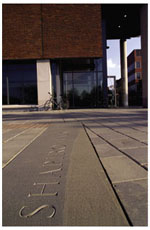May 15, 2002: From the Editor
Photo: Shapiro Walk, named for former President
Harold Shapiro, runs through a new quad in the northeast corner of campus.
(Ricardo Barros)

During one of our abnormally warm and sunny February days, I strolled across campus. My route took me past the Woodrow Wilson School, or Robertson Hall as it is formally known, which, like approximately 75 percent of Princeton’s buildings, is currently under construction. (The university is redoing Scudder Plaza — that’s the fountain — adding trees and shrubbery and redesigning the fountain itself so that when the water is turned off in the winter the plaza will still be a pleasant place to sit.)
I passed between the orange barricades and over the plywood path and wound down the steps with Corwin Hall on my right. I looked up — and was startled to find a quadrangle I hadn’t realized existed. What was once a weedy back alley is now a landscaped space, bounded by the Wallace Social Science Center, the Friend Center, the Computer Science Building, and the glassy façade of the University Press addition. Shapiro Walk, which I was on that day, cuts neatly through the space leading to Olden Street. Another inviting path stretches past erstwhile Dial Lodge, notorious for its basement during my undergraduate tenure but now reborn as the beautifully refurbished and eminently respectable Bendheim Center for Finance.
Excited by my discovery, I decided a photo essay of the emerging campus would be just the ticket for alumni returning for Reunions, and scheduled the story for the May issue. We’d shoot photos of some of the buildings (16 of them, I learned later) that had been erected in the past 15 years, and try to capture the feeling of walking around campus today.
I scheduled a meeting with Jon Hlafter ’61 *63, director of physical planning and the architect of the emerging landscape, to find out what buildings and areas we should feature. When I described my mission, he looked at me doubtfully; I was surely the only person in 10 years who had proposed taking pictures of the campus, buried as it is in scaffolding, mud, and heavy equipment. The problem, he explained gently, is that we’re only partway through the effort.
Unfazed, I told him of my epiphany by Wallace, and suggested that PAW could show what progress had been made. Slowly he warmed to the idea, suggesting completed projects such as Frist, Friend, the boathouse, and the new athletics facilities.
The results are on pages 18—21. The photos won’t
erase the overall feeling of “Pardon Our Mess,” but they may
provide a ray of hope for those suffering through Princeton’s rebuilding
years. ![]()

